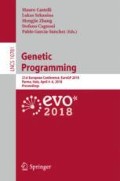Abstract
We carry out a comparison of popular asymmetric metrics, originally proposed for scoring association rules, as building blocks for a fitness function for evolutionary inductive programming. In particular, we use them to score candidate multi-relational association rules in an evolutionary approach to the enrichment of populated knowledge bases in the context of the Semantic Web. The evolutionary algorithm searches for hidden knowledge patterns, in the form of SWRL rules, in assertional data, while exploiting the deductive capabilities of ontologies.
Our methodology is to compare the number of generated rules and total predictions when the metrics are used to compute the fitness function of the evolutionary algorithm. This comparison, which has been carried out on three publicly available ontologies, is a crucial step towards the selection of suitable metrics to score multi-relational association rules that are generated from ontologies.
Access this chapter
Tax calculation will be finalised at checkout
Purchases are for personal use only
Notes
- 1.
- 2.
The result is a KB with an enriched expressive power. More complex relationships than subsumption can be expressed.
- 3.
To guarantee decidability, only DL-safe rules are sought for [16], i.e., rules interpreted under the DL-safety condition, whose variables are bound only to explicitly named individuals in \(\mathcal {K}\). When added to an ontology, DL-safe rules are decidable and generate sound, but not necessarily complete, results.
- 4.
- 5.
- 6.
References
Agrawal, R., Imielinski, T., Swami, A.N.: Mining association rules between sets of items in large databases. In: Proceedings of the International Conference on Management of Data, pp. 207–216. ACM Press (1993)
Baader, F., Calvanese, D., McGuinness, D.L., Nardi, D., Patel-Schneider, P.F. (eds.): The Description Logic Handbook: Theory, Implementation, and Applications. Cambridge University Press, New York (2003)
Berners-Lee, T., Hendler, J., Lassila, O.: The semantic web. Scientific American (2001)
Breiman, L., Friedman, J., Olshen, R., Stone, C.: Classification and regression trees, New York, USA (1984)
Brin, S., Motwani, R., Ullman, J.D., Tsur, S.: Dynamic itemset counting and implication rules for market basket data. In: Proceedings of 1997 ACM SIGMOD International Conference on Management of Data, pp. 255–264 (1997)
Clark, P., Boswell, R.: Rule induction with CN2: some recent improvements. In: Proceedings of the Fifth European Conference, pp. 151–163 (1991)
d’Amato, C., Staab, S., Tettamanzi, A., Tran, D.M., Gandon, F.: Ontology enrichment by discovering multi-relational association rules from ontological knowledge bases. In: Proceedings of SAC 2016. ACM (2016)
d’Amato, C., Tettamanzi, A.G.B., Minh, T.D.: Evolutionary discovery of multi-relational association rules from ontological knowledge bases. In: Blomqvist, E., Ciancarini, P., Poggi, F., Vitali, F. (eds.) EKAW 2016. LNCS (LNAI), vol. 10024, pp. 113–128. Springer, Cham (2016). https://doi.org/10.1007/978-3-319-49004-5_8
Divina, F.: Genetic Relational Search for Inductive Concept Learning: A Memetic Algorithm for ILP. LAP LAMBERT Academic Publishing (2010)
Fanizzi, N., d’Amato, C., Esposito, F.: Learning with kernels in description logics. In: Železný, F., Lavrač, N. (eds.) ILP 2008. LNCS (LNAI), vol. 5194, pp. 210–225. Springer, Heidelberg (2008). https://doi.org/10.1007/978-3-540-85928-4_18
Fu, L.M., Shortliffe, E.H.: The application of certainty factors to neural computing for rule discovery. IEEE Trans. Neural Netw. 11, 647–657 (2000)
Galárraga, L., Teflioudi, C., Hose, K., Suchanek, F.: AMIE: association rule mining under incomplete evidence in ontological knowledge bases. In: WWW 2013, pp. 413–422. ACM (2013)
Horrocks, I., Patel-Schneider, P.F., Boley, H., Tabet, S., Grosof, B., Dean, M.: SWRL: a semantic web rule language combining OWL and RuleML (2004). http://www.w3.org/Submission/2004/SUBM-SWRL-20040521/
Józefowska, J., Lawrynowicz, A., Lukaszewski, T.: The role of semantics in mining frequent patterns from knowledge bases in description logics with rules. Theory Pract. Logic Program. 10(3), 251–289 (2010)
Lisi, F.A.: AL-QuIn: an onto-relational learning system for semantic web mining. Int. J. Semant. Web Inf. Syst. 7(3), 1–22 (2011)
Motik, B., Sattler, U., Studer, R.: Query answering for OWL-DL with rules. Web Semantics 3(1), 41–60 (2005)
Muggleton, S., Tamaddoni-Nezhad, A.: QG/GA: a stochastic search for progol. Mach. Learn. 70(2–3), 121–133 (2008)
Reiser, P., Riddle, P.: Scaling up inductive logic programming: an evolutionary wrapper approach. Appl. Intell. 15(3), 181–197 (2001)
Sahar, S., Mansour, Y.: An empirical evaluation of objective interestingness criteria. In: SPIE Conference on Data mining and Knowledge Discovery, pp. 63–74 (1999)
Smyth, P., Goodman, R.: Rule Induction Using Information Theory. MIT Press, Cambridge (1991)
Tran, M.D., d’Amato, C., Nguyen, B.T., Tettamanzi, A.G.B.: An evolutionary algorithm for discovering multi-relational association rules in the semantic web. In: GECCO, pp. 513–520. ACM (2017)
Völker, J., Niepert, M.: Statistical schema induction. In: Antoniou, G., Grobelnik, M., Simperl, E., Parsia, B., Plexousakis, D., De Leenheer, P., Pan, J. (eds.) ESWC 2011. LNCS, vol. 6643, pp. 124–138. Springer, Heidelberg (2011). https://doi.org/10.1007/978-3-642-21034-1_9
Author information
Authors and Affiliations
Corresponding author
Editor information
Editors and Affiliations
Rights and permissions
Copyright information
© 2018 Springer International Publishing AG, part of Springer Nature
About this paper
Cite this paper
Duc Tran, M., d’Amato, C., Nguyen, B.T., Tettamanzi, A.G.B. (2018). Comparing Rule Evaluation Metrics for the Evolutionary Discovery of Multi-relational Association Rules in the Semantic Web. In: Castelli, M., Sekanina, L., Zhang, M., Cagnoni, S., García-Sánchez, P. (eds) Genetic Programming. EuroGP 2018. Lecture Notes in Computer Science(), vol 10781. Springer, Cham. https://doi.org/10.1007/978-3-319-77553-1_18
Download citation
DOI: https://doi.org/10.1007/978-3-319-77553-1_18
Published:
Publisher Name: Springer, Cham
Print ISBN: 978-3-319-77552-4
Online ISBN: 978-3-319-77553-1
eBook Packages: Computer ScienceComputer Science (R0)

